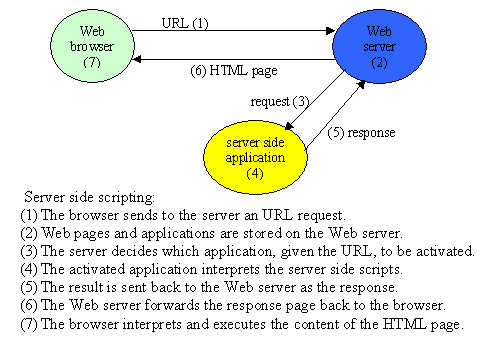T. Andrew Yang
(yang@grove.iup.edu)
Computer Science Department
-
Introduction to Web Development
-
Server side development
-
Curriculum Design
Designing and Teaching a Web Development Course
| Ø Server Side Development |
-
Interpreted or executed by the server side applications, along with the Web server.
-
The result is then sent back to the Web browser.

Ö Server Side Technologies
-
Active Server Pages
-
Java Servlets
-
Java Server Pages
-
Distributed Components-Based Technology
CORBA, DCOM, EJB, RMI, ...
Ö A recent testing survey at http://www.eweek.com/a/pcwt0010311/2646051/
-
Four leading dynamic scripting products were evaluated: cfm, jsp, asp, php
-
Evaluation criteria
-
The language's API
-
Tools
-
Back-end connectivity
-
| Products | Strengths |
|
ColdFusion Server (Allaire) |
Exceptionally easy to use APIs; Market-leading development tools |
|
Tomcat (Apache Group's implementation of JSP) |
Suitable for multi-tier or critical infrastructure projects; Rich APIs provided by the JAVA language (scalability from browsers to business objects to servers) |
|
ASP (Microsoft) |
Excellent tools; Its ubiquity on Microsoft platforms |
|
PHP (Open Source) |
Broad platform support; Highly extensible; Good performance; Built from the ground up as a Web application development language |
- Issues
Simplicity versus performance
Manageability
Scalability
Fault Tolerance
Ö Database Connections
-
JDBC: Java Database Connectivity
-
ODBC: Open Database Connectivity
-
OLE-DB
-
ADO: ActiveX Data Objects
|
Next: summary |